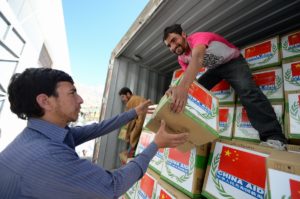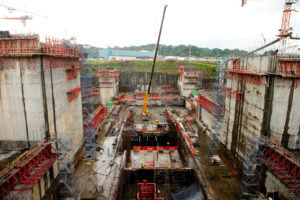China’s newly established foreign aid agency (China International Development Cooperation Agency, CIDCA) recently released draft Measures for the Administration of Foreign Aid to solicit public comments. This move understandably attracts international attention as observers are eager to learn how the new agency would operate, and, more importantly, how any external stakeholders – including recipient countries, contractors and civil society – may participate in and influence the aid process.
Expectations are high. Chinese foreign aid has long been known for its opaqueness. For years, external researchers and observers had to rely on infrequent white papers to get a glimpse of the scope of the country’s aid programme. Piecing together fragmented information on Chinese aid to render a more complete picture has become an effort that entire research programs undertake. With the release of the new draft rules, many hope that Chinese foreign aid may become more transparent and accessible.
But before people get too excited about the opportunity to reshape Chinese foreign aid, it is important to clearly understand what the draft measures can achieve and their limitations.
What the draft measures do
As a new agency born out of the ministerial reshuffle early last year, the new measures define CIDCA’s core business: the process of designing, implementing and reviewing foreign aid projects.
It is worth noting that even though CIDCA is new, the draft measures are not. Before CIDCA became China’s coordinating government body for foreign aid, the Ministry of Commerce (MOFCOM) was the main aid distributor, while multiple other agencies shared bits and pieces of foreign aid responsibilities. The draft measures are built on an earlier MOFCOM version, which was announced and came into effect in 2014, with new elements reflecting the agency’s expanded mandate.
Beyond taking over the supervision of four types of foreign aid projects previously overseen by MOFCOM (complete projects, material donation projects, technical assistance projects and capacity building projects), CIDCA also assumes an important strategic planning role, drawing up foreign aid strategies and plans at the national level. Plus, the multiple streams of aid-related finance, including grants, interest-free loans and concessional loans, will all be subject to CIDCA’s overall budgetary oversight. In the case of South-South cooperation funds jointly set up by CIDCA and other governmental departments, the agency will directly run and distribute those funds.
The draft measures distil CIDCA’s mandate into a set of concrete policy items that will be created along the process of the agency’s fulfilment of its responsibilities. These include:
- A top-level foreign aid strategy (unclear frequency, possibly approved by State Council)
- A long-term to mid-term policy plan (unclear frequency, possibly approved by State Council)
- Country-by-country aid policies
- An annual foreign aid plan (possibly approved by State Council)
- A foreign aid management system
- Foreign aid international cooperation system
- An annual foreign aid budget
- measures to manage the initiation and approval of aid projects
- A project evaluation system
- A credit rating system for project implementers
- Foreign aid statistics collection
Many details are missing from the draft measures, and some items, such as the process of initiating and approving actual foreign aid projects, require their own stand-alone measures to be fully hashed out. But still, a skeleton of the policy framework that will govern Chinese foreign aid in the future is visible from the draft.
Understanding the constraints of the draft measures
Promising as they are, the draft measures have a few built-in limitations that would put clear boundaries around ways external stakeholders may interact with Chinese foreign aid.
The first and foremost limitation lies in its relatively low legal force according to the Legislation Law. The draft measures rank as a “departmental rule” issued by a ministry/agency under the State Council. Within the hierarchy of the Chinese legal system, laws passed by the National People’s Congress are bestowed with the highest legal authority. Beneath them are regulations created by the State Council (the Cabinet). While rules promulgated by government departments and local provincial people’s councils are lower down the legal ladder.
In principle, lower-level regulations and rules cannot go beyond what higher-level laws authorise them to do. In the case of CIDCA’s draft measures, as a departmental rule, their legal force is circumscribed by a few higher-level laws and regulations, including, but not limited to, China’s Law of Administrative Permission, Law of Administrative Penalty, State Council Open Governmental Information Regulation, and Law of Administrative Reconsideration. The draft measures are also bound by the agency’s approved mandate and duties set by the State Council.
Those higher-level legal instruments erect a wall around the measures. For instance, many would like to see more accountability built into the measures by creating stronger penalties for violating rules set by the measures. Yet, the Law of Administrative Penalty and related State Council rules set a RMB 30,000 (US$4,431) ceiling for fines that government agencies can legally impose, which is adopted by CIDCA in the draft. The cap on fines is supposed to serve as a check against the abuse of administrative power.
Some Chinese companies, including those who implemented or are implementing foreign aid projects, have been criticised for offering bribes in Africa and Latin America
Nevertheless, a US$4,431 limit set by the State Council in 1996, is a questionable deterrent today. In the same vein, CIDCA can only impose two types of administrative penalties: disciplinary warnings and fines. The agency is also not allowed to use the measures as a vehicle to create new roles for itself. For example, even though stronger Environmental and Social Impact Assessments of Chinese aid projects could be a desirable development, without a State Council authorisation for CIDCA to involve the Ministry of Ecology and Environment in the management of foreign aid projects, the agency won’t be able to take on the role on its own. To overcome some of the intrinsic weaknesses of the draft rule, CIDCA would need to muster enough political support to elevate the draft measures to a higher level (such as a State Council regulation).
What can be improved
As a draft for comment, the measures in their current form definitely have much space for improvement. One area that can be improved is information disclosure. This is not an unreasonable ask. The State Council’s 2008 Open Governmental Information Regulation (China’s freedom of information act) constitutes the legal basis for demanding greater transparency from government agencies. Article 9 of the Regulation requires government agencies to proactively disclose information that “needs to be widely known and participated by the public.” Arguably, dispensing public resources to assist foreign countries deserves public knowledge and participation. In theory, many policy items listed above should be released publicly to keep the society informed of where foreign aid is going. Yet no disclosure related clause currently exists in the draft measures.
2005
the year China ratified the UN Convention Against Corruption
The draft measures by itself can’t impose criminal liabilities, but it indicates that anyone who violates Chinese Criminal Law and other laws during the licensing and implementation of foreign aid projects may be subject to criminal liabilities. Unfortunately, the draft measures don’t echo the second paragraph in article 164 of the Criminal Law, which states: “Whoever gives any property or benefit to a functionary of a foreign country or an official of an international public organisation for any improper commercial benefit shall be punished according to the provision of the preceding paragraph.” This provision was added to China’s Criminal Law after China signed and ratified the UN Convention Against Corruption in 2005, but it has never been used to prosecute Chinese persons and legal persons for bribery overseas. Some Chinese companies, including those who implemented or are implementing foreign aid projects, have been criticised for offering bribes in Africa and Latin America.
The draft measures also lack an explicit grievance mechanism for external stakeholders, particularly those affected by Chinese foreign aid projects, to report wrongdoings and submit complaints. This appears to backtrack from its predecessor. MOFCOM’s 2014 measures at least included one clause that allows “any individual or entity” to report to the ministry when they find Chinese implementers in non-compliance. Besides pressing CIDCA to reintroduce such a mechanism into the rule, one may also find openings in Chinese administrative laws to challenge certain agency decisions. In theory, “administrative licensing” can be questioned on the basis of the Administrative Reconsideration Law, which grants citizens and organisations the right to plea for reconsideration of permissions that violate their interest.
The draft measures contain a few approval/licensing components. For example, approval of foreign aid projects in the draft measures is an “administrative licensing” by nature. Whether third parties can trigger a reconsideration petition for such approvals on grounds of affected interest is subject to legal interpretation. But in the past, Chinese civil society groups have successfully used the legal tool to overturn government decisions, such as the greenlighting of problematic Environmental Impact Assessments. It will be interesting to see if such clauses can be activated to bring some accountability to Chinese foreign aid in the future.
This article was originally published on the blog Panda Paw Dragon Claw and is reposted here with permission.








